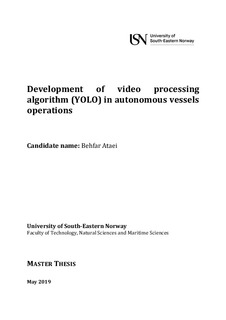| dc.description.abstract | In recent years, the maritime sector has had a growing interest in the development of
autonomous vessels. These new and emerging operational paradigms have gained attention
from maritime industry stakeholders through research and development projects, which have
subsequently generated a number of both scaled and full-scale vessel prototypes. However, todate
there is a lack of empirical data of real-world autonomous vessels operations. Thus, the
majority of research in this domain is limited to conceptual models and feasibility studies.
This thesis focuses on utilizing computer vision as a technology for collision avoidance
system in autonomous vessels operations. This study compares the video recordings of a
passenger vessel (Ole III) frequently operating in a 120 meters width water crossing using three
different methods: (1) observer onboard Ole III (2) manual video observations and (3) computer
algorithm. You Only Look Once (YOLO) version 3 is selected as a suitable computer algorithm
for video analysis because of its high processing speed and real-time capability. This algorithm
is trained by analyzing the video data of passing water traffic and evaluated by comparing it to
the observation data manually collected by human observers onboard the vessel and the manual
video observations. The main research goal is to test the potential of the YOLO computer
algorithm and compare it with the observational data for application in the maritime sector.
By comparing the data processed by the algorithm with the observation data, the
algorithm can be evaluated and improved for further applications in autonomous vessels. The
higher accuracy of YOLO in detection was attributed to the availability of the data in the
training phase. This explains the poor performance of the algorithm when evaluating the data
out of the training set. This study applied YOLO to the experimental settings resulting in 95%
accuracy in detection, which is within the same range as the benchmarks with similar settings.
Although this method shows promise for autonomous vessels applications, further research is
required to assess the safety aspects related to the implementation of this technology. | nb_NO |
